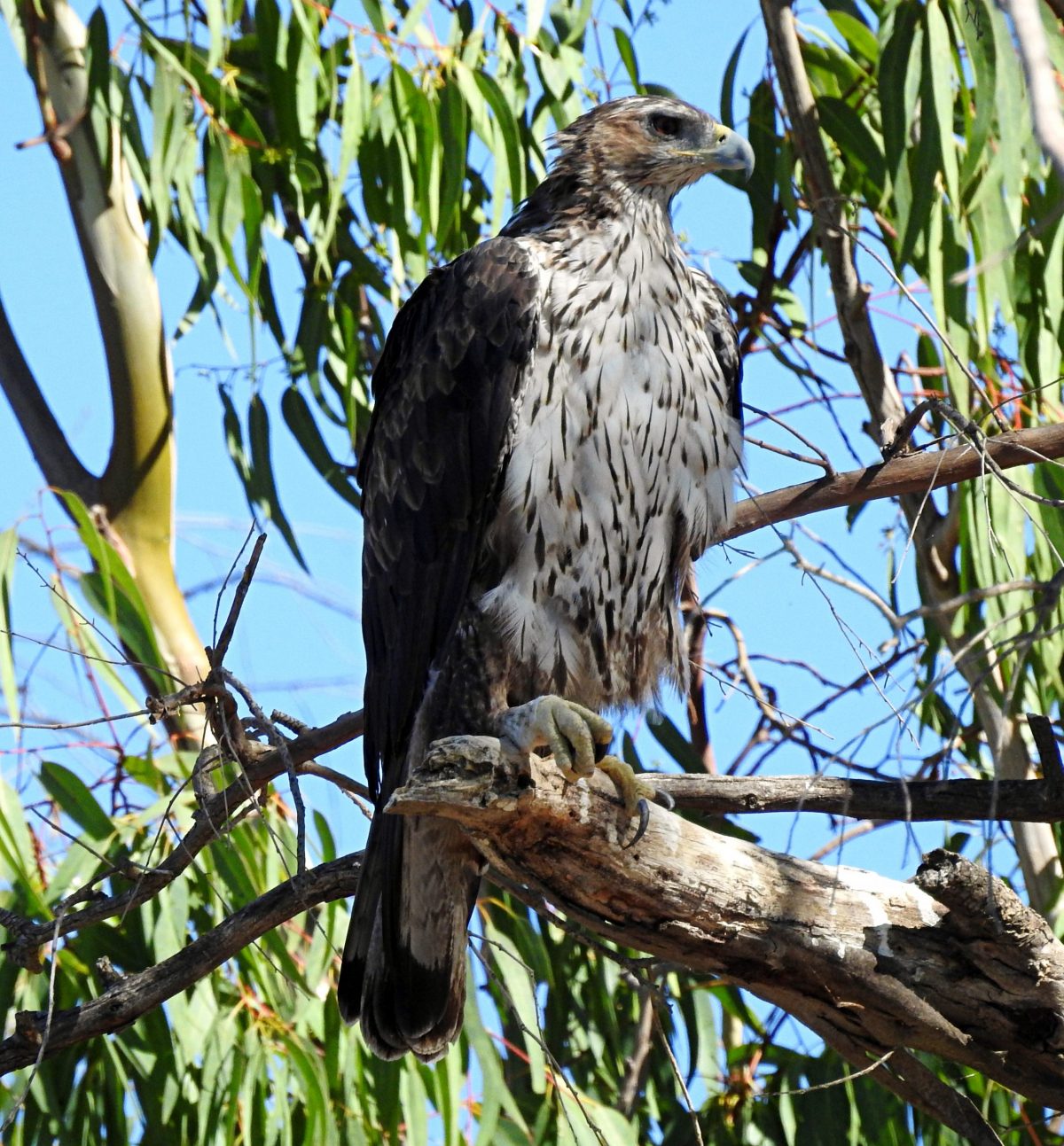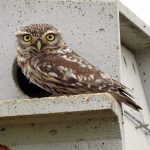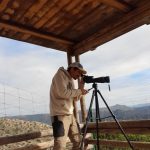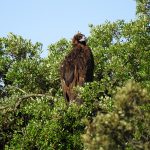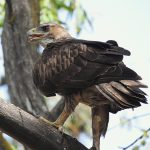Here you will find all the diurnal raptors of Extremadura.
Bearded vulture Gypaetus barbatus
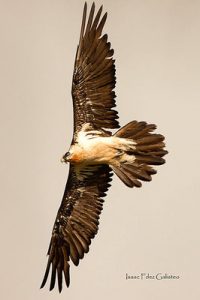
Although she is not a resident bird of prey in the community, young birds are frequently seen and it is hoped that a couple will soon settle down. This is one of the biggest diurnal raptors of Extremadura, and specializes in the consumption of bones and tendons, and therefore contributes to the integral use of the animal cadavers. Its silhouette is unmistakable, with a triangle-shaped tail and a yellowish ventral area (in adult specimens). The young specimens are dark and as they grow, the plumage of their underparts lightens. In Extremadura, there are several sightings in Monfragüe, Los Canchos de Ramiro and also occasionally in Las Villuercas.
Black kite Milvus migrans
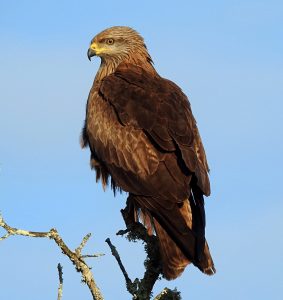
Similar to the red kite, it differs from it by being slightly smaller, having less contrast in its coloring and the V of the tail less pronounced. Typical inhabitant also of the pastures of Extremadura and the Mediterranean mountain in summer, it migrates in winter to Africa. Like the Red Kite, it nests in large, dense trees. A few years ago it was much less frequent than the red kite but its population has decreased much less and it is still relatively frequent.
Black-winged kite Elanus caeruleus
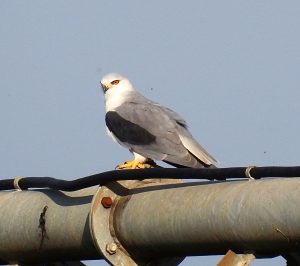
A small, colourful bird of prey, it is common to find it in cultivated areas and meadows with scattered trees. The population of Extremadura is very important. In winter it receives a large number of individuals from national micro-migrations, which come to Extremadura in search of a less hostile habitat. It mainly feeds on small rodents, and its population has increased slightly in recent decades. La Albuera, La Campiña Sur, dehesas of Jerez, the area of Orellana, La Moheda alta, Cornalvo, Los Canchales, Arrocampo and Monfragüe are the best places to observe it.
Bonelli’s eagle Aquila fasciata
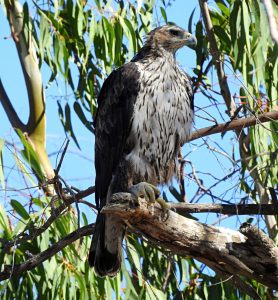
Along with the imperial one, they are probably the two eagles that are the emblem of the community. Extremadura hosts the main population centres of the species in the Iberian Peninsula. It lives in areas of rocky areas and low mountain ranges, being relatively frequent in cliffs and steep banks of some reservoirs. Adults have a white breast with spots but juveniles have a beautiful cream colour.
Feeding on small vertebrates, the alarming regression of the common rabbit has been one of its greatest threats. Currently pigeons and partridges are its main prey, although it is one of the most aggressive diurnal raptors and can hunt prey the size of a heron. The best areas to see this distrustful bird of prey are the Tiros mountains, the central mountains of Badajoz, the Pela mountains, Villuercas, the Tajo and Almonte rock cuts near the Alcántara reservoir, Canchos de Ramiro, Tajo Internacional, Monfragüe and the Gata mountains.
Booted eagle Hieraaetus pennatus
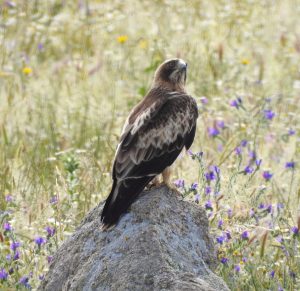
The smallest of the eagles present in Extremadura, and also the most abundant. Slightly smaller than a kite, it is unmistakable for its black and white colours when it flies over us. Some specimens however have a dark morph, which makes it more difficult to identify, especially when it is at long distances. An excellent predator, it feeds on small vertebrates of all kinds. Summer visitor, we can locate it in all the pastures, not very thick forests and open spaces of the region.
Cinereous vulture Aegypius monachus
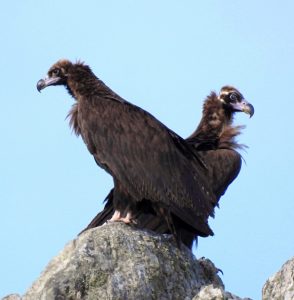
Among the diurnal raptors of Extremadura, it is the largest, also of Spain and Europe. Extremadura has 40% of the country’s population and is relatively easy to locate if we are in the right areas. It differs from the Griffon Vulture in the colour black, its larger size, its longer tail and that in flight it keeps its wings flat (the Griffon usually carries them in a V). Monfragüe, Sierra de San Pedro, Sierra de Gata, Las Hurdes and Granadilla (near Gabriel y Galán lake) house the main breeding nuclei and are therefore excellent areas for observation.
Common buzzard Buteo buteo
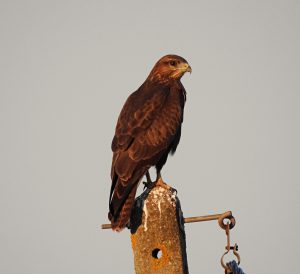
Similar in size to the kite, it is one of the most abundant diurnal birds of prey in Extremadura, although it is also threatened by current agricultural practices such as the widespread use of poisons to combat pests. Inhabitants of the meadows, edges of streams and crops, it is often seen climbing the lampposts waiting for its time to pounce on some small rodent. In winter we can see him hunting bigger game, even catching adult rabbits.
Common kestrel Falco tinnunculus
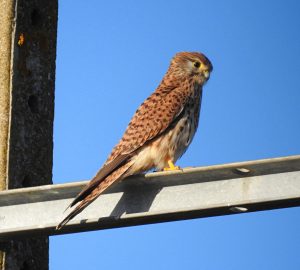
A very abundant bird of prey that, despite being damaged by modern agricultural practices, maintains numerous populations. It is very well adapted to the rural environment, and its ability to “hover” is particularly striking, killing itself even for several minutes in the air in order to better locate its prey. It feeds on small rodents and invertebrates in meadows and pastures with trees scattered throughout the region.
Common sparrowhawk Accipiter nisus
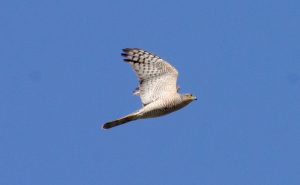
Forest raptor, very similar in appearance to the goshawk but much smaller in size. Especially active at dawn and dusk, if we are lucky we can see it flying over the boundaries hunting small birds with its incredible agility. It also lives in all types of mature forests although it is able to move away a little to hunt in other nearby ecosystems. Relatively abundant in Extremadura, we can see it all year round because although some individuals migrate to Africa to spend the winter, other central European specimens come to spend the winter in Extremadura.
Egyptian vulture Neophron percnopterus
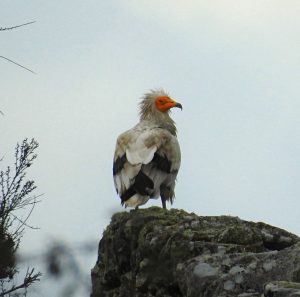
It is the smallest scavenger bird of prey in Extremadura. Unmistakable by its black and white tones, it nests in rocky cliffs but moves tens of kilometers in search of food. It is very intelligent as it is capable of using instruments (stones) to break ostrich eggs. It is present in the peninsula in spring and summer to reproduce. We can locate it in the vicinity of mountains and rocks: Tiros, Villuercas, Pela, San Pedro, central mountains of Badajoz, Tajo Internacional, Canchos de Ramiro, Monfragüe, Llanos de Cáceres …
Eurasian hobby Falco subbuteo
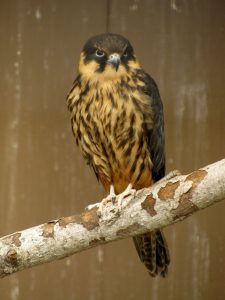
The size of a kestrel but with an appearance more similar to that of the peregrine falcon, it stands out for its acrobatic flight, being able to hunt very agile birds such as swallows or martins. It visits Extremadura in spring to breed and is more frequent in Badajoz than in Cáceres but rather scarce in the region. It nests in small forest patches near meadows, fields and crops where it usually feeds. The east of Badajoz and the southeast of Cáceres are the areas with the highest population densities.
European honey buzzard Pernis apivorus
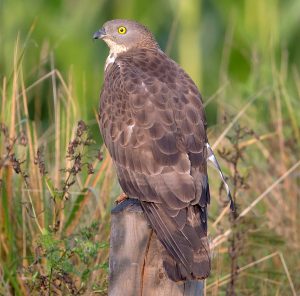
Similar in size to a buzzard, it is easily confused with it due to the wide variety of colors that both species have. Its yellow iris is very characteristic of the species, it nests in trees in thick forests and it is the only one of the diurnal raptors of Extremadura that feeds only on invertebrates, mainly wasps and bees. A summer visitor, its populations are rather scarce and we can find it in Villuercas, La Vera, Jerte and Ambroz valleys and in Granadilla lands.
Golden eagle Aquila chrysaetos
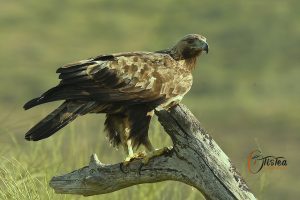
It is the largest of the European eagles, very robust and strong. It hunts all kinds of vertebrates, even capable of hunting prey the size of a fox or baby deer. The golden eagle nests in large trees or rocky outcrops and its population is relatively stable. We can observe it in practically any area of the community, above all near the mountain ranges, having a home range of tens of square kilometers. At present its conservation status is not a cause for concern, although like all large birds of prey it is highly dependent on rabbit populations.
Goshawk Accipiter gentilis
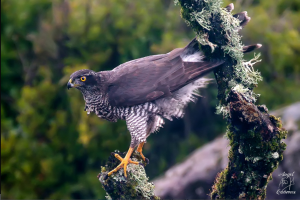
The most elusive of the diurnal raptors of Extremadura, clearly a forest bird of extraordinary beauty, is one of the most skilful birds of prey due to its incredible agility. A regular inhabitant of mature forests of all types of trees, its range of prey is tremendously varied, being able to capture everything from small birds to large prey the size of a hare. Very difficult to observe due to the fact that it is an extremely distrustful bird, we can see it if we are very lucky in the forests around Sierra Brava, Villuercas, Monfragüe, Gata, Tajo Internacional, Valle del Ambroz and in the area of Granadilla.
Griffon vulture Gyps fulvus
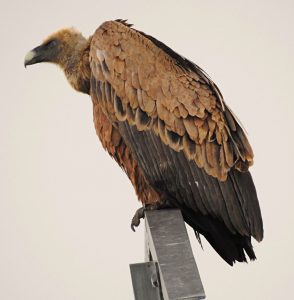
Slightly smaller than the cinereus vulture and much more abundant than him, we can see it practically all over the community. We can find concentrations in all the mountain ranges of the community, especially those with large rocks, where it nests. Monfragüe or Los Canchos de Ramiro near Alcántara lake are 2 excellent examples in which we can see dozens of couples.
Hen harrier Cyrcus cyaneus
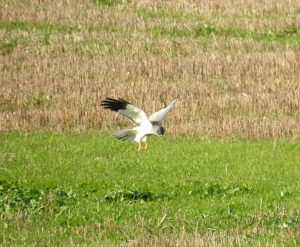
Slightly smaller than the western marsh harrier, the male is pale grey and the female dark brown with a spotted ochre belly. The young specimens are also brown. Easily confused with Montagu’s Harrier, it is a regular inhabitant of open fields devoid of trees. Present in Extremadura mainly in winter, some specimens stay all year round. It feeds mainly on small rodents and invertebrates and the best areas for sighting them are Llanos de Cáceres, Magasca and Trujillo, Campiña Sur, La Serena, La Albuera, La Moheda Alta and the vicinity of Arrocampo.
Imperial eagle Aquila adalberti
This endemic eagle of the Iberian Peninsula is the most threatened in our peninsula and finds in Extremadura one of its main centres of population.
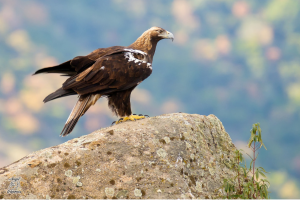
It nests in large trees in the thickness of the Mediterranean mountain, where it hunts all kinds of small and medium sized animals. Some of the best spots for its sighting are the mountain range of Monfragüe, Llanos de Trujillo, Alcántara lake, the mountain ranges of Coria, Tierra de Barros and the mountain range of San Pedro. The surroundings of the tail of Peña del Águila lake is one of the best spots to see it, along with most of the community’s endangered diurnal raptors.
Lesser kestrel Falco naumanni
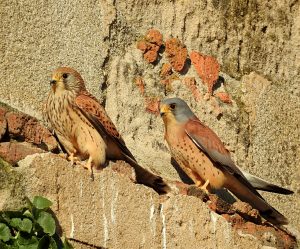
Very similar to the common kestrel, its most evident difference is the nails, white in the case of the lesser. It nests very frequently in holes or cracks in churches and other buildings, even if it has to make long journeys afterwards to hunt. Slightly smaller than the common kestrel, its diet is more insectivorous although it also hunts small rodents. Its population is more threatened than that of the common one, but in recent years it seems to have stabilised. We can observe it in the spring and summer months all over the region, as they spend the winter in Africa
Merlin Falco columbarius
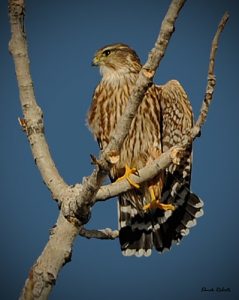
The smallest of the diurnal raptors of Extremadura, wintering on the Iberian Peninsula, it is slightly larger than a turtledove. It feeds on birds that it hunts in the open. Its main habitats are grasslands, crops and sparsely wooded pastures. It is a rather scarce bird of prey and we can highlight for its observation La Campiña Sur, La Albuera or Arrocampo.
Montagu’s harrier Cyrcus pigargus
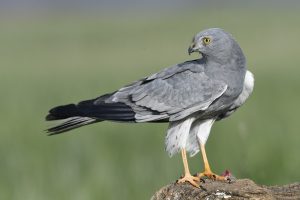
A little smaller than the pale one, they are two really similar birds. The males have a black list on their wings, absent on the hen one, and the females are more stylised and have a lighter band on their wing tips. It nests in the cereal fields so it is necessary the collaboration of the farmers to guarantee its reproduction. Their populations are quite threatened and we can observe them during the spring and summer months in La Campiña Sur, La Albuera, the Serena, Llanos de Cáceres, the environment of Orellana and Sierra Brava, the area of Cornalvo and Los Canchales.
Osprey Pandion haliaetus
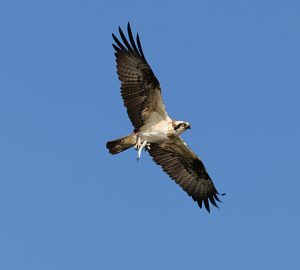
Medium-sized eagle that specializes in catching fish, the only one between the diurnal raptors of Extremadura. It lives in river ecosystems: large wetlands, rivers, lakes and reservoirs, being very scarce both in the country and in the region. Easily identified in flight by its arched silhouette and its white colors in the belly and interior areas of the wings. We can observe it in Sierra Brava, Cornalvo, Los Canchales, Azud de Badajoz, Peña del Águila, Arrocampo and Gabriel y Galán.
Pallid harrier Circus macrourus
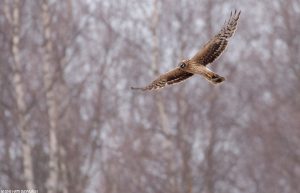
Very similar to Hen and Montagu’s harriers, although the males are easily differentiated by their smoother shades. Inhabitant of open spaces, pastures, grazing lands, crops… in which it feeds on rodents, small birds and invertebrates. It does not usually live in the region, although there are dozens of references in both provinces.
Peregrine falcon Falco peregrinus
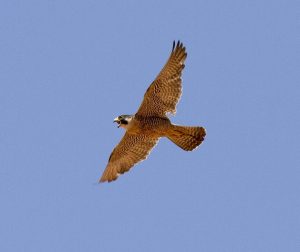
It is the fastest of the diurnal raptors of Extremadura, but also of all the world’s birds of prey, capable of exceeding 300 km/h in its swooping flights. Of medium size, it lives in areas of rocks and cliffs where it nests, being really aggressive and scaring away much larger birds of prey. It is not very abundant and normally captures medium sized birds such as doves or turtledoves, but it is capable of capturing birds twice its size such as bustards or ducks. It usually hunts in open fields and we can observe it in the mountains of Tiros, Villuercas, Pela, San Pedro, Monfragüe, Canchos de Ramiro, La Vera, Valle del Jerte and Granadilla.
Red kite Milvus milvus
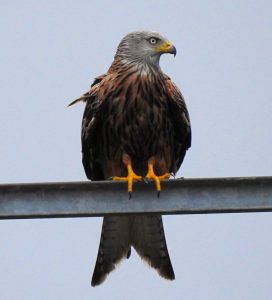
Despite being one of the most abundant diurnal raptors in the Iberian Peninsula, its population has been drastically reduced in recent years and is now seriously threatened. It lives all year round in Extremadura, and its permanent population is reinforced in winter with the arrival of Central European birds. A typical bird of the “dehesas”, it is distributed throughout the region and we can easily observe it flying over the roads in search of small animals that have been run over.
Short-toed snake eagle Circaetus gallicus
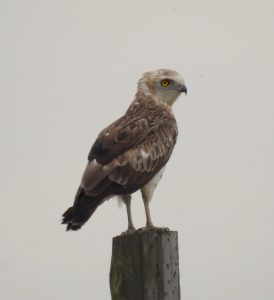
A large eagle, although a little smaller than the royal or imperial eagle. It is perfectly distinguished in flight by its whitish tones both in the ventral regions and inside its wings, with small bars or brown spots. It visits us in spring and returns to Africa at the end of summer as it feeds mostly on reptiles. The short-toed snake eagle nests in large trees near its hunting grounds. We can see it flying over open spaces in search of snakes, lizards and other reptiles. Without reaching great densities it is relatively frequent.
Western marsh harrier Circus aeruginosus
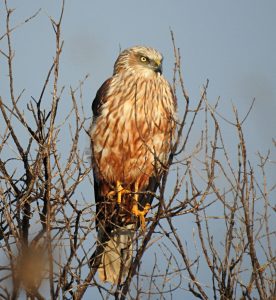
It is the largest harrier in the region, frequenting wetlands, rice fields and other crops that have marshy vegetation nearby. It nests on the ground and is a great hunter, being able to capture prey up to the size of a duck. Stable and growing population in Extremadura, where it is present all year round. Although it can be seen practically all over the region, we have good populations in the fertile plains of the Zújar and Guadiana rivers, the lakes of Almaraz and Canchales, La Albuera, Tierra de Badajoz, La Serena…
Thanks to Álvaro de las Heras, Ángel Cañones, Jorge Lázaro and Isaac Fdez Galisteo for the picures.

